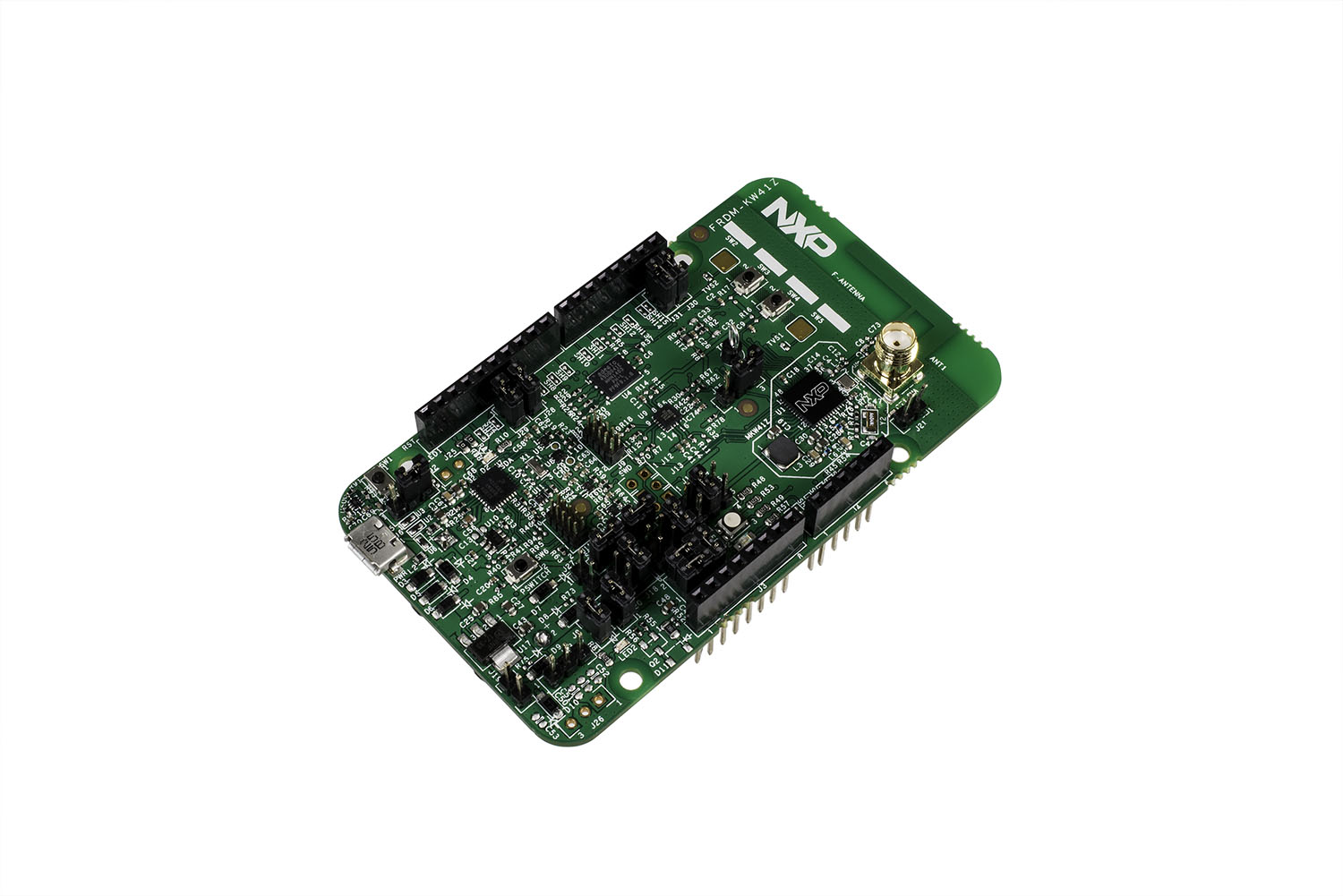NXP FRDM-KW41Z¶
Overview¶
The FRDM-KW41Z is a development kit enabled by the Kinetis® W series KW41Z/31Z/21Z (KW41Z) family built on ARM® Cortex®-M0+ processor with integrated 2.4 GHz transceiver supporting Bluetooth® Smart/Bluetooth® Low Energy (BLE) v4.2, Generic FSK, IEEE® 802.15.4 and Thread.
The FRDM-KW41Z kit contains two Freedom boards that can be used as a development board or a shield to connect to a host processor. The FRDM-KW41Z is form-factor compatible with the Arduino™ R3 pin layout for more expansion options.
The FRDM-KW41Z highly-sensitive, optimized 2.4 GHz radio features a PCB F-antenna which can be bypassed to test via SMA connection, multiple power supply options, push/capacitive touch buttons, switches, LEDs and integrated sensors.

Hardware¶
- Can be configured as Host or Shield for connection to Host Processor
- Supports all DC-DC configurations (Buck, Boost, Bypass)
- PCB inverted F-type antenna
- SMA RF Connector
- RF regulatory certified
- Serial Flash for OTA firmware upgrades
- On board NXP FXOS8700CQ digital sensor, 3D Accelerometer ( ±2g/ ±4g/ ±8g) + 3D Magnetometer
- OpenSDA and JTAG debug
For more information about the KW41Z SoC and FRDM-KW41Z board:
- KW41Z Website
- KW41Z Datasheet
- KW41Z Reference Manual
- FRDM-KW41Z Website
- FRDM-KW41Z User Guide
- FRDM-KW41Z Schematics
Supported Features¶
The frdm_kw41z board configuration supports the following hardware features:
| Interface | Controller | Driver/Component |
|---|---|---|
| NVIC | on-chip | nested vector interrupt controller |
| SYSTICK | on-chip | systick |
| PINMUX | on-chip | pinmux |
| COUNTER | on-chip | rtc |
| GPIO | on-chip | gpio |
| I2C | on-chip | i2c |
| SPI | on-chip | spi |
| ADC | on-chip | adc |
| UART | on-chip | serial port-polling; serial port-interrupt |
| FLASH | on-chip | soc flash |
| SENSOR | off-chip | fxos8700 polling: fxos8700 trigger |
The default configuration can be found in the defconfig file:
boards/arm/frdm_kw41z/frdm_kw41z_defconfig
Other hardware features are not currently supported by the port.
Connections and IOs¶
The KW41Z SoC has three pairs of pinmux/gpio controllers, but only two are currently enabled (PORTA/GPIOA and PORTC/GPIOC) for the FRDM-KW41Z board.
| Name | Function | Usage |
|---|---|---|
| PTC1 | GPIO | Red LED / FXOS8700 INT1 |
| PTA19 | GPIO | Green LED |
| PTA18 | GPIO | Blue LED |
| PTB2 | ADC | ADC0 channel 3 |
| PTC2 | I2C1_SCL | I2C / FXOS8700 |
| PTC3 | I2C1_SDA | I2C / FXOS8700 |
| PTC4 | GPIO | SW3 |
| PTC5 | GPIO | SW4 |
| PTC6 | LPUART0_RX | UART Console |
| PTC7 | LPUART0_TX | UART Console |
| PTC16 | SPI0_SCK | SPI |
| PTC17 | SPI0_SOUT | SPI |
| PTC18 | SPI0_SIN | SPI |
| PTC19 | SPI0_PCS0 | SPI |
System Clock¶
The KW41Z SoC is configured to use the 32 MHz external oscillator on the board with the on-chip FLL to generate a 40 MHz system clock.
Serial Port¶
The KW41Z SoC has one UART, which is used for the console.
Programming and Debugging¶
Build and flash applications as usual (see Build an Application and Run an Application for more details).
Configuring a Debug Probe¶
A debug probe is used for both flashing and debugging the board. This board is configured by default to use the OpenSDA DAPLink Onboard Debug Probe.
Option 1: OpenSDA DAPLink Onboard Debug Probe (Recommended)¶
Install the pyOCD Debug Host Tools and make sure they are in your search path.
Follow the instructions in OpenSDA DAPLink Onboard Debug Probe to program the OpenSDA DAPLink FRDM-KW41Z Firmware.
Option 2: OpenSDA J-Link Onboard Debug Probe¶
Install the J-Link Debug Host Tools and make sure they are in your search path.
Follow the instructions in OpenSDA J-Link Onboard Debug Probe to program the OpenSDA J-Link FRDM-KW41Z Firmware.
Add the argument -DOPENSDA_FW=jlink when you invoke cmake or west
build to override the default runner from pyOCD to J-Link:
# On Linux/macOS
cd $ZEPHYR_BASE/samples/hello_world
mkdir build && cd build
# On Windows
cd %ZEPHYR_BASE%\samples\hello_world
mkdir build & cd build
# Use cmake to configure a Ninja-based build system:
cmake -GNinja -DBOARD=frdm_kw41z -DOPENSDA_FW=jlink ..
# Now run ninja on the generated build system:
ninja
Configuring a Console¶
Regardless of your choice in debug probe, we will use the OpenSDA microcontroller as a usb-to-serial adapter for the serial console.
Connect a USB cable from your PC to J6.
Use the following settings with your serial terminal of choice (minicom, putty, etc.):
- Speed: 115200
- Data: 8 bits
- Parity: None
- Stop bits: 1
Flashing¶
Here is an example for the Hello World application.
# On Linux/macOS
cd $ZEPHYR_BASE/samples/hello_world
mkdir build && cd build
# On Windows
cd %ZEPHYR_BASE%\samples\hello_world
mkdir build & cd build
# Use cmake to configure a Ninja-based build system:
cmake -GNinja -DBOARD=frdm_kw41z ..
# Now run ninja on the generated build system:
ninja flash
Open a serial terminal, reset the board (press the SW1 button), and you should see the following message in the terminal:
***** Booting Zephyr OS v1.14.0-rc1 *****
Hello World! frdm_kw41z
Debugging¶
Here is an example for the Hello World application.
# On Linux/macOS
cd $ZEPHYR_BASE/samples/hello_world
mkdir build && cd build
# On Windows
cd %ZEPHYR_BASE%\samples\hello_world
mkdir build & cd build
# Use cmake to configure a Ninja-based build system:
cmake -GNinja -DBOARD=frdm_kw41z ..
# Now run ninja on the generated build system:
ninja debug
Open a serial terminal, step through the application in your debugger, and you should see the following message in the terminal:
***** Booting Zephyr OS v1.14.0-rc1 *****
Hello World! frdm_kw41z